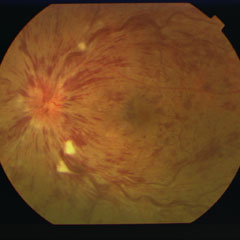 |
Common Eye Conditions
Retinal Vascular Disorders
|
This group of disorders refers to conditions which affect the arteries and veins in the retina, thus causing visual loss. These are:
Branch Retinal Vein Occlusion (BRVO)This occurs when part of a vein draining the retina is blocked by adjacent blood vessels, leading to hemorrhages (or bleeding) into the retina behind the occluded portion. |
Males and females are equally affected.
Risk factors for retinal vein occlusion include:
- advanced age, especially those in their 60s and 70s
- hypertension
- coronary artery disease
- stroke
- smoking
- glaucoma
- in younger patients, inflammatory and inherited conditions affecting blood vessels and blood viscosity
The symptoms of BRVO are a sudden onset of a blurred or missing area of vision, in conjunction with the risk factors mentioned. It is easily diagnosed by the eye doctor, using ophthalmoscopy and fluorescein angiography.
The complications of BRVO are:
- edema and ischemia of the macula
- glaucoma
- abnormal growth of new blood vessels in the retina, which then result in visual defects.
Treatment of BRVO is primarily directed at managing these complications and includes laser and pharmacological therapies.
Central Retinal Vein Occlusion
This involves occlusion of the final retinal vein, which collects and drains all the blood from the retina. The risk factors, complications and treatment of CRVO are similar to those of BRVO.
Visual loss in CRVO, however affects mainly central vision.
Retinal Artery Occlusion
This condition is a ‘stroke’ in the eye and is an ocular emengency. It arises from blockage of the central retinal artery or one of its branches, typically by a blood clot (or embolus) in the blood stream. This deprives the affected portion of the retina of oxygen and nutrients, causing permanent visual loss.
Risk factors for retinal artery occlusion include:
- coronary artery disease
- hypertension
- diabetes
- smoking
- glaucoma
In some patients, there may be a transient loss of vision prior to the occlusion.
After the occlusion has occurred, the visual loss is sudden and painless, with
- partial loss if an arterial branch is involved
- complete loss if the central artery is involved
Diagnosis is by ophthalmoscopy.
There is no treatment that can restore the visual loss in retinal artery occlusion.
Common Eye Conditions
- Age Related Macular Degeneration
- Blepharitis
- Cataracts
- Central Serous Chorioretinopathy
- Contact Lens Problems
- Diabetes and the Eye
- Dry Eyes
- Floaters and Flashes
- Glaucoma
- LASIK Surgery
- Pterygium and Pingueculae
- Refractive Errors
- Retinal Detachment
- Retinal Vascular Disorders
- Uveitis and Ocular Inflammations
- Vision Problems in Children
